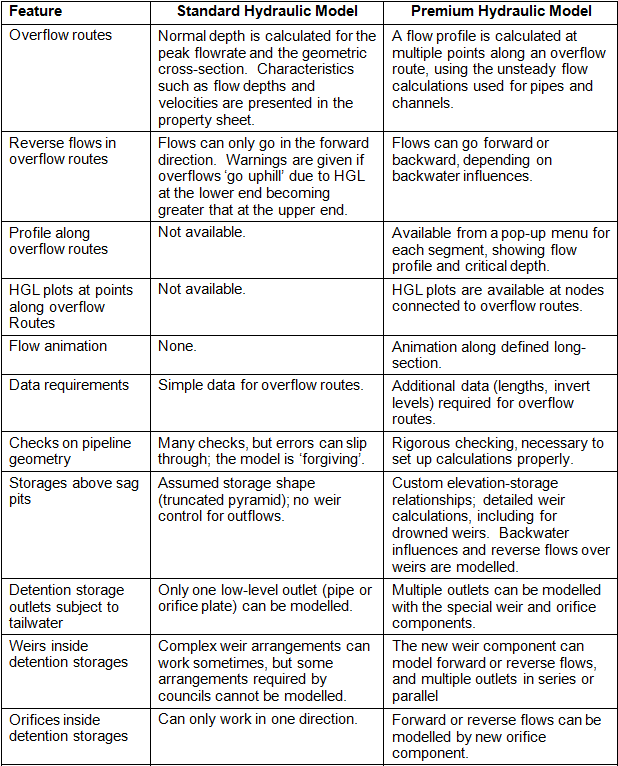DRAINS Hydraulic Models
The following table sets out the differences between the two hydraulic models used in DRAINS:

These differences have developed due to the way that DRAINS developed. Initially, flow depths and characteristics were calculated by a combination of hydraulic grade line projections and full pipe system modelling. This, now superseded basic model operated as a series of steady states, creating a quasi-unsteady result. When the Lite and Full Unsteady hydraulic models were developed, these were provided for pipes and open channels in the Lite hydraulic model, but unsteady flow modelling of overflow routes and other features were made available when utilising the Full unsteady hydraulic model.
These differences have developed due to the way that DRAINS developed. Initially, flow depths and characteristics were calculated by a combination of hydraulic grade line projections and full pipe system modelling. This, now superseded basic model operated as a series of steady states, creating a quasi-unsteady result. When the Lite and Full Unsteady hydraulic models were developed, these were provided for pipes and open channels in the Lite hydraulic model, but unsteady flow modelling of overflow routes and other features were made available when utilising the Full unsteady hydraulic model.
In the Full unsteady hydraulic model, all conduits (pipes, channels and overflow routes), are modelled using the same procedure, so there is more consistency in modelling, and results are more accurate. There will often be lower peak flowrates due to the modelling of storage effects along overflow routes and at sag pits.
Related Articles
The Lite and Full Unsteady Hydraulic Models
(a) Introduction Introduced in 2010, the Standard and Premium hydraulic model procedures superseded the Basic hydraulic model that had been applied in DRAINS since its first release. In 2020 the Standard hydraulic model was renamed to Lite hydraulic ...Storage routing models
(a) General As well as the standard Horton (ILSAX) hydrological model for simulating flows from urban areas, DRAINS has optional storage routing models based on procedures applied in three hydrological models that have been used in Australia since ...DRAINS Examples
Files for a number of short examples are located in the folders C:\ProgramData\Drains, in folders named 'LiteExamples' and 'FullUnsteadyExamples' (C:\ProgramData\Drains may not be visible because it is often hidden in Windows. To make it visible, ...Hydraulic grade line analysis
This is a form of hydraulic analysis of piped drainage systems that traces the positions of hydraulic grade lines throughout the system. It is usually applied as a steady state model, calculating HGLs for the peak flowrates at each pipe in a system. ...Methods used in DRAINS
(a) Introduction DRAINS offers a new design model for pipe systems, detention basins and other facilities that runs with ARR 2019 sets or 'ensembles' of ten design storms for a selected number of storm durations. This detailed procedure is that same ...